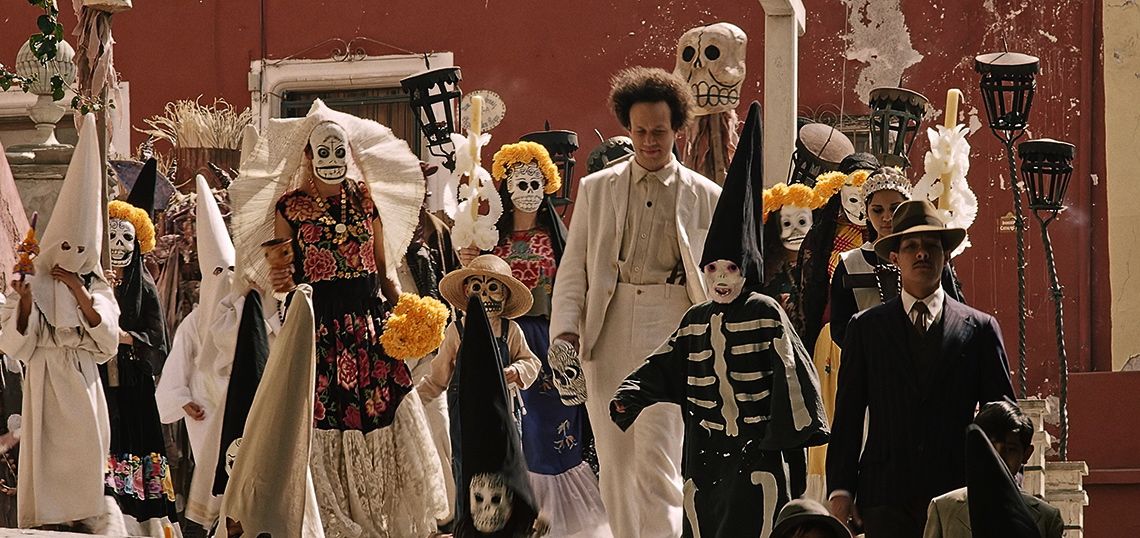
Films like Eisenstein in Guanajuato must pose particular dilemmas for Film Festival programmers. On the one hand, it’s a film of near-constant ingenuity and audacity, the type of film that hardened cinephiles could rave enthusiastically about or outright reject. But it’s a film so hard to categorise or even understand at a fundamental level that the task of selling and marketing this film is not an enviable one. Nor is it a task, I fear, to which more mainstream distributors will rise when it comes to the question of home video release or theatrical distribution. But in the meantime, I can recommend this film to more open-minded viewers as a film of delirious energy that may not always work in its stylistic and narrative idiosyncrasies, but one that never stops trying.
The Eisenstein of the title is, of course, the legendary Russian director and film theorist Sergei whose films Strike and Battleship Potemkin, along with his conception of montage, revolutionised cinema. He was also one of the many European masters that Hollywood tried to attract in the 1920s and 30s as the growing industry sought to strength itself with best talent available; F.W. Murnau, Fritz Lang, Otto Preminger and Douglas Sirk were just some of the film and theatre directors that were successfully head-hunted . For various reasons the financial and artistic relationship envisioned did not work out, and before returning to Russia Eisenstein worked on the film ¡Que viva México! south of the border, an episode which English director Peter Greenaway (The Cook, The Thief, His Wife and Her Lover) takes great pleasure in dramatizing and speculating upon. As the film says twice, 10 Days That Shook the World was the American title of Eisenstein’s October, a chronicle of Russia’s 1917 October Revolution, and the director’s foray in Guanajuato could be titled 10 Days That Shook Eisenstein. Not just a clever appropriation, Greenaway is clearly being playful in drawing a thread between the two films; Eisenstein clearly took some poetic license in his dramatisation of that event for artistic and political reasons, and Greenaway takes a similar approach in his historical reimagination, turning in a fictionalised history similarly exaggerated, energetic and only slightly less cataclysmic.
The production of the film, one of the great production blunders in cinema history, is not portrayed in detail. Produced by leftist author Upton Sinclair and his wife, connected with Eisenstein through their mutual associate Charles Chaplin, the film about Mexican recent history didn’t eventuate, and suspected by Stalin as a deserter, Eisenstein was ultimately brought back to Russia. Eisenstein in Guanajuato is more concerned with the personal side of this venture, of Mexico as a utopian experience of awakening and self-realisation for the repressed director (played by Finnish actor Elmer Bäck), something intrinsically connected with his first sexual experiences at age 33, that Greenaway shoots quite graphically as he makes love with his Mexican guide Palomino (Luis Alberti) interspersed with quite Greenawayian conversations about sex and (figurative and literal) death. In one of the few instances of restraint in the film, Greenaway doesn’t make definitive claims as to the effect this awakening has on Eisenstein’s art, though the audience will make their own inferences; there is a potential connection posited between the restless, erratic energy of something like Battleship Potemkin and Eisenstein’s own sexual frustration, something absent in the later, post-Guanajuato and more serene Ivan the Terrible films.
Exactly how the film is told is more striking than what is told, a clash of visuals and sounds along with a relentless energy that makes it one of the more peculiar visual offerings in the Festival program. Black-and-white segments, three-panel split screen shots, swirling 360 degree panoramas, rear projected backdrops and lavish, exaggerated sets; just about every trick in the book is pulled out in some point in this film, obtaining a peculiar mix between the more realistic scenes, and a brightly coloured and lit artificial kitsch aesthetic reminiscent of the late films of Alain Resnais. Central to all of this is the caricature performance of Eisenstein himself. Bäck’s performance is like a ball of manic energy and neuroses, accentuating the Russian’s renowned eccentricity and drawing attention to the less advantageous physical features of Eisenstein’s (often nude) body which Greenaway shoots to get a sense of the grotesque.
Ultimately, some will be put off by the comic exaggerations and idiosyncrasies of the whole affair. Perhaps it’s most interesting as a crass historical reimagination closer to Horrible Histories than a BBC biopic, and it’s actually somewhat informative as Bäck’s Eisenstain rattles off anecdotes and historical trivia along side superimposed historical photographs and other contextual documents.1 There’s actually an educational value to be had as well, were this sexually explicit film allowed within ten miles of a classroom. For so many casual film buffs Eisenstein’s filmography is about as close to ‘cinematic vegetables’ as you can get, and the perceived dry figure is certainly brought to life and then some. It’s an unusually inventive and entertaining account of film history, and almost certainly the first to show an esteemed director holding a conversation with his own penis. It’s not for all tastes, but this sort of adventurous programming is one of the things film festivals are made for.
Around the Staff
| Virat Nehru | |
| Felix Hubble |
